
Droop Nose
During takeoff and landing, Concorde flew at a steep angle, with its
front end tilted skyward and its tail pointing down. If a
conventional plane were in this position, its nose would block the
pilots' view. But Concorde's long, pointed nose had a hinge. As the
plane took off, landed, and taxied, the pilots tilted its nose
forward so that they could see the runway. For supersonic flight,
the nose was hydraulically lifted, streamlining the plane's shape
and allowing it to efficiently pierce the air.
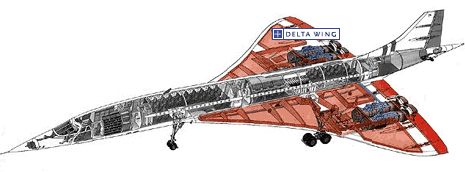
Delta Wing
It's a classic aerodynamic problem: most wing shapes that perform
well at high speeds by minimizing "drag" don't have the "lift"
needed for takeoff. The solution for Concorde was an elegant delta-
or triangular-shaped wing reminiscent of 1950s military aircraft. It
had few moveable parts compared to the wing of a subsonic jet, but
the sleek delta wing was aerodynamically complex. It took over 5,000
hours of wind-tunnel testing before Concorde's designers and
engineers were confident they had the optimal shape.

Turbojet Engines
Concorde's four turbojet engines were twice as powerful as engines
on large subsonic jets. Mounted in pairs under the wings, each
engine could provide more than 38,000 lbs of thrust, accelerating
the plane from 0 to 225 mph in only 30 seconds. At takeoff and again
when Concorde zoomed from Mach 1 (the speed of sound) toward Mach 2,
raw fuel was injected into the engine exhaust, providing a powerful
boost. This afterburner system was similar to technology used today
by fighter jets and the Space Shuttle. It gave Concorde's engines a
fiery glow (and also made them extremely loud).

Air Intakes
Most jet engines wouldn't perform well if they took in air flowing
at supersonic speeds. Concorde's ingeniously designed air intakes
slowed down the air rushing toward the engines. Even when the plane
reached its top cruising speed of 1,350 mph, the speed of airflow to
the engines remained less than 300 mph. Concorde's air intake
system, developed 40 years ago, is still leading-edge technology
today.
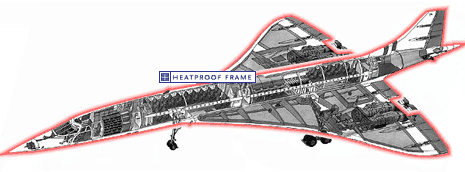
Heatproof Airframe
Flying at Mach 2—roughly 1,350 miles per hour—wind
friction quickly raises the surface temperature of an aircraft's
airframe. Concorde's nose could heat to 260°F, a temperature
that would shatter ordinary glass, so engineers devised a visor for
the nose cone made of several layers of special glass to protect the
flight deck. The high temperatures also caused Concorde's
titanium and steel skin to expand—the plane stretched as much
as ten inches in length during flight. A specially developed white
paint accommodated this stretching and dissipated the heat generated
by supersonic speeds.
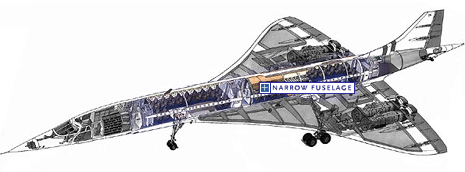
Narrow Fuselage
With an overall length of 202 feet and a fuselage only 10 feet wide,
Concorde seemed more akin to a streamlined rocket than a subsonic
aircraft. It was about the same length as a Boeing 747 but had a
fuselage three times as narrow. Concorde's long, slender body
reduced the increased drag caused by supersonic flight. Admiring its
graceful form, one of Concorde's engineers remarked that its sleek
look was a by-product of the laws of physics rather than a target of
the design team.

Automated Flight
Technology enabling planes to "fly themselves," automatically
adjusting parameters such as pitch or heading, existed before
Concorde. But the system in Concorde's cockpit was far more
sophisticated. While they had to monitor the system, Concorde's
pilots could fly "hands free" through much of a flight. The
autothrottle maintained high Mach speeds even when wind direction
and other environmental conditions changed. The autopilot kept the
plane on course and even guided the aircraft to a touchdown point on
the runway, landing the aircraft like an expert pilot would.
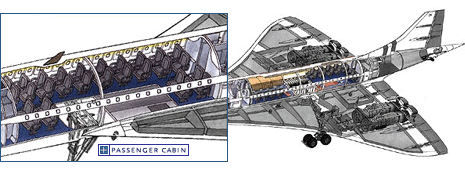
Passenger Cabin
Concorde's aerodynamic, narrow body restricted space for passengers.
British Airways planes seated only 100, while Air France planes,
with a slightly roomier cabin layout, sat just 92. Given Concorde's
gas-guzzling, costly operation, you paid dearly for the chance to go
supersonic. But with a $10,000 round-trip ticket, you flew in high
style—toasting your takeoff with caviar and champagne,
followed by a five-course gourmet meal. Eleven miles high, above 90
percent of Earth's atmosphere, the ride was rarely rocked by
turbulence, and the view of our planet's curvature was spectacular.
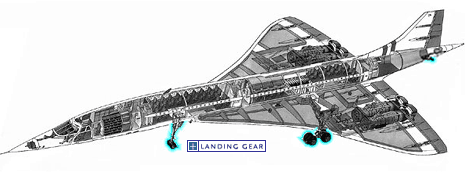
Landing Gear
Concorde's landing gear was state-of-the-art in the 1960s. Antilock
breaks, now standard on cars and aircraft, were first developed to
prevent Concorde from skidding as it landed at high speeds. In
addition to two tires near the nose of the plane and four under each
wing, the plane has "bumper gear" beneath its tail in case it tips
to the ground during takeoff or landing. In July 2000, a ruptured
tire, shredded by a piece of metal lying on the runway during
takeoff, caused a crash that killed 113 people and ultimately
contributed to Concorde's retirement.
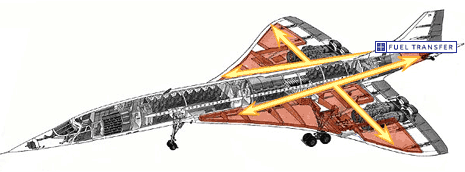
Fuel Transfer
At takeoff, Concorde carried roughly 31,500 gallons of fuel weighing
more than 200,000 pounds, an enormous weight that, depending on the
fuel's location, changed the plane's center of gravity. A
fuel-transfer system adjusted the center of gravity and helped to
keep Concorde stable. Before takeoff and during acceleration to
supersonic speeds, about 20 tons of fuel was moved backwards to
tanks in the plane's tail and wings. As the aircraft slowed down at
the end of a flight, fuel was pumped forward to a tank near the
plane's center.

|

|











